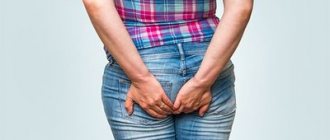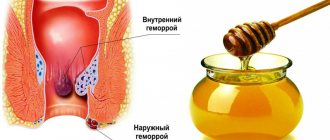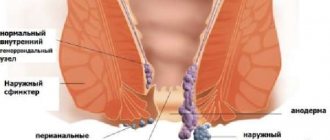Hemorrhoids are a vascular pathology, and are a process of enlargement of the venous plexuses located in the rectum. There may be several reasons for the occurrence, but in most cases the main role in this is played by an incorrect lifestyle. That is why men are more likely to suffer from this disease, since they tend to get involved in bad habits and unhealthy diets.
When diagnosing hemorrhoids in men, treatment is an extensive set of means and methods by which the causes of the disease, its negative consequences, as well as the current manifestations of the disease are eliminated. Unfortunately, most male proctologist patients are in no hurry to see a doctor when the first signs of pathology appear, which is why their condition is aggravated by the appearance of new symptoms. As a result, the number of treatment methods used is also increasing.
It is important for men to remember that the sooner you start treatment, the less time it will take to restore your health.
Causes of hemorrhoids
According to statistics, the question of how to treat hemorrhoids most often arises in men after 35 years of age. With age, the relevance of this problem increases, and the reason for this is the weakening of the walls of blood vessels. The following factors can trigger this process:
- congestion in the pelvic veins due to a sedentary lifestyle;
- regular constipation, including due to poor nutrition;
- bad habits - smoking and alcohol;
- lifting weights;
- inflammatory processes in the intestines and pelvic organs;
- obesity.
Eliminating these provoking factors is an important point in speeding up the treatment of hemorrhoids in men.
Internal hemorrhoids stage 2
The situation is getting worse. Main symptoms of stage 2:
- Bleeding from the anus. If at first there were traces of blood, now it is full-fledged bleeding of a bright scarlet color.
- Loss of nodes means that the disease is advanced. Sometimes you can fix it yourself, but most often you have to see a doctor.
These unpleasant symptoms begin to bother you after physical activity, coughing, sneezing, even at rest. This indicates the advanced stage of the disease.
Diagnostic measures
Anoscopy is a method for diagnosing hemorrhoids.
In the early stages, it is impossible to diagnose this disease yourself. Only an experienced doctor is able to determine the type of disease and its stage. Instrumental methods are used to diagnose internal hemorrhoids:
- Anoscopy - the doctor examines the inner surface of the rectum using a special endoscope. The procedure is performed on an outpatient basis and does not require anesthesia or special preparation - a cleansing enema is sufficient. The doctor has the opportunity to examine 14 cm of the rectum. Contraindication – acute inflammatory process in the anal area.
- Sigmoidoscopy - the procedure is similar to anoscopy, but allows you to examine up to 25 cm of the rectum and colon. At the same time, a tissue biopsy is performed. The procedure is also performed on an outpatient basis, without anesthesia, and is allowed even for preschool children. Contraindication – bleeding from the anus in the active phase.
Preparation for sigmoidoscopy is as follows:
- Gentle diet
- Several sessions of cleansing enemas throughout the day
- Irrigoscopy is an x-ray examination of the rectum and colon using a contrast agent.
- Colonoscopy is used not only for diagnostic purposes, but also for treatment.
- Digital examination - in this case, it is used only for diagnosing nodes located in the immediate vicinity of the anus.
Treatment tactics
Infrared photocoagulation is a procedure for eliminating hemorrhoids.
Treatment of the patient depends on the diagnosis and severity of the disease. Your doctor may suggest the following methods:
- Conservative
- Minimally invasive procedures
- Surgical intervention
The conservative method involves the use of various medications. The best option for internal hemorrhoids is rectal suppositories and tablet forms. NSAIDs, sea buckthorn suppositories, and belladonna suppositories are used as local treatment. For oral administration, venotonics are prescribed - Detralex, Phlebodia and similar drugs. Minimally invasive procedures for internal hemorrhoids:
- Infrared photocoagulation is the effect of light quanta on the affected area. The nodes shrink and dry out.
- The procedure is performed on an outpatient basis. The disadvantage of this method is the likelihood of blood clots forming at the treatment site.
- Ligation with special latex rings. An anoscope is used for this procedure. It's simple - the nodes are pulled together in rings, blood circulation is disrupted and the tumor dies. The intervention, although effective, is quite painful. During 1 visit to the doctor, only 1 node is processed.
Other methods - laser coagulation, cryodestruction - similar photocoagulation are carried out according to indications and at the choice of the attending physician.
Symptoms of hemorrhoids in men
The symptomatic picture of the disease in men differs little from that observed in women. You can suspect you have the disease based on the following signs:
- pain during bowel movements;
- discharge of drops of blood during bowel movements;
- burning and itching in the anus;
- feeling of the presence of a foreign object in the rectum;
- swelling of the anus and the appearance of nodes, which at first independently return to their original position, then require manual reduction, and later cannot be put back into place manually.
Initially, the symptoms of hemorrhoids are mild, so few patients decide to visit a doctor and find out how to treat hemorrhoids - among men, visiting a proctologist is often considered a shameful thing. Meanwhile, without therapy, the pathology progresses, and instead of mild discomfort, the man begins to experience acute pain, and instead of a few drops of blood, he is bothered by severe bleeding.
Clinical signs
General symptoms do not depend on the location of the affected lesions and appear:
- constipation;
- mucous discharge;
- slight bleeding during and after defecation;
- sensation of the presence of a foreign body;
- anal fissures;
- burning and itching;
- the addition of a secondary infection.
Formed nodes are visible at all stages of the disease. Distinctive features of the external type of pathology include pain and bleeding. Injuries to the lumps are associated with tight underwear, bowel movements, hard stools, etc. Hemorrhoids have a purple or purplish-bluish tint. If the process has reached the point of thrombosis, then black areas of necrosis can be seen on them.
Diagnostic methods
Only a proctologist can confirm the diagnosis in men. It is he who conducts the first examination of the patient, and also carries out the following diagnostic measures:
- visual inspection of the anus;
- palpation of the rectum;
- instrumental examination of the rectum - anoscopy, sigmoidoscopy, irrigoscopy and colonoscopy.
With their help, the doctor can exclude the presence of other pathologies whose symptoms are similar to hemorrhoids, and also determine the degree of change in hemorrhoids.
Why does the disease occur in the fair sex?
The causes of hemorrhoids in women are often the same as in young people, but with the addition of new factors.
- Hormonal imbalances during pregnancy lead to constipation. Thickened feces form microcracks as they move forward, causing severe pain, in response to which the body delays the process of defecation. At the same time, the discharge becomes even denser. The vicious circle can be broken with the help of special medications prescribed by a doctor, or folk remedies: eating beets, prunes. For normal metabolism, it is very important to drink as much clean water as possible, this stabilizes the body's water balance.
- During difficult childbirth, strong tension contributes to ruptures in the rectal mucosa, the formation of nodes, compactions, and inflammatory processes that cause the development of scars and adhesions that partially cover the width of the anus. To prevent undesirable consequences of hemorrhoids, it is important after childbirth to undergo examinations with a proctologist and gynecologist every six months.
- The reasons for the exacerbation of hemorrhoids may lie in diets that deplete the body, for example, separate meals. When some “healers” advise eating only uncooked buckwheat or eating more hot spices, which supposedly promote weight loss. In fact, poor nutrition and mucosal irritating additives are bad luck for the intestines.
Gentle, beneficial weight loss methods can only be recommended by a qualified nutritionist. Do not fall for the provocative advertisements of thick, colorful magazines. The advice published in them often has no scientific basis.
Treatment methods for hemorrhoids
When hemorrhoids are diagnosed in men, treatment begins depending on the stage of the disease. As a rule, it represents the effect on hemorrhoids with local or systemic medications. From the second stage, minimally invasive and surgical methods are used.
Unlike conservative and radical surgical treatment, minimally invasive methods can be used from the second stage of hemorrhoids, and the patient can lead his previous lifestyle without long-term rehabilitation. They are the ones who are preferred in most cases. Treatment of hemorrhoids in men in this case is carried out using the following methods:
- sclerotherapy - administration of a sclerosing solution into the cavernous part of the node, used at stages 1 and 2 of the disease;
- ligation - used at stages 1, 2 and rarely at stages 3 of the disease, it involves tightening the stem of the node with a latex ring;
- laser coagulation - “sealing” of the vessels feeding the node with a laser, used at stages 1, 2 and 3 of the disease;
- cryodestruction - exposure of the cavernous tissue of the node to low temperatures.
All of the above procedures do not require long preparation, are practically painless and take a few minutes. After they are completed, the patient can leave the clinic.
Stages of hemorrhoids
Hemorrhoids can be acute (when the disease develops rapidly and is accompanied by severe pain and discomfort) and chronic. In the second case, a mild pain syndrome is observed, the disease develops over a long period of time with periods of exacerbation (bleeding, prolapse and pinched nodes occur).
First stage
Mild discomfort is felt, and short-term bleeding is typical, which occurs after any overexertion - hard work, defecation. Inflammation is detected only during examination. At this stage, conservative treatment, sclerotherapy, and photocoagulation are recommended.
Second stage
It is characterized by periodic prolapse of inflamed hemorrhoids, while bleeding may be absent. The dropped nodes are set on their own without much effort. Conservative treatment, sclerotherapy, photocoagulation, ligation, or a combination of these techniques is recommended.
Third stage
Dystrophic changes occur in the sphincter, it weakens, as a result of which prolapsed hemorrhoids can only be set manually. The course of the disease is accompanied by severe itching, frequent and heavy bleeding. Ligation, surgical treatment, and a combination of techniques are recommended.
Fourth stage
Hemorrhoids are in a constantly prolapsed state along with the rectal mucosa. It is impossible to set them. It may be accompanied by bleeding or occur without it. Inflammation can affect nearby tissues. Surgery to remove hemorrhoids is indicated.
Drug treatment
Drug therapy is used from the onset of the first symptoms of the disease, since hemorrhoids in men can only be effectively treated in combination. If a man turns to a proctologist before the venous plexuses in the rectum have undergone significant changes, they can completely relieve him of discomfort and restore vascular tone.
Among oral medications, men are prescribed phlebotropic drugs Detralex, Phlebodia 600, Pilex, Ginkor-forte and others. They have a phlebotropic effect and help eliminate congestion - the main cause of hemorrhoids.
Among local remedies, men are prescribed suppositories and ointments with anti-inflammatory, phlebotropic, analgesic effects: Relief, Procto Glyvenol, Proctosan, Posterisan and Heparin ointment.
It is not recommended to find out how hemorrhoids are treated in men in online publications and popular printed sources. Only a doctor can choose a truly effective remedy for a specific patient!
How to get hemorrhoids in your youth
Why in our time do hemorrhoids sometimes occur at a very tender age? The most common causes of hemorrhoids in girls and boys:
- insufficient consumption of raw vegetables and fruits against the background of overeating processed meats, sweet fatty confectionery products, baked goods, fast foods;
- reduced intake of clean water into the body, which almost children still compensate for with sweet, concentrated carbonated drinks;
- the factor of inactivity, which arises from long-term sitting at the computer, provokes the development of stagnation of feces, intestinal atony, and insufficient emptying;
- sitting on the toilet for a long time, in an incorrect position, forces you to forcefully squeeze out condensed feces, due to the previously listed reasons. This leads to the appearance of microcracks, which are immediately infected by pathogenic microbes;
- colds resulting from recklessly following the “cries of fashion”: wearing short jackets with “fish” fur, trousers and skirts with low hips, exposing the back in the cold;
- hypothermia resulting from drinking alcoholic beverages, when young people do not react to the cold due to excessive “hotness”;
- in some cases, sexual promiscuity leads to lesions of the anus.
All causes of hemorrhoids , if desired, can be easily eliminated. It is the direct responsibility of parents and teachers to promptly tell young and foolish teenagers what terrible consequences hemorrhoids can lead to. This is thrombosis of hemorrhoidal vessels, leading to their necrosis, purulent complications - paraproctitis, anemia.
Prevention of hemorrhoids in men
You can prevent the appearance and development of hemorrhoids in men using standard healthy lifestyle methods:
- eat regularly, giving preference to vegetables, fruits and grains that are high in fiber;
- ensure normal digestion and blood circulation by engaging in an active life - walking and classical exercises in the morning and throughout the day will be enough;
- give up bad habits that weaken blood vessels;
- moderate physical activity and do not lift heavy objects;
- maintain intimate hygiene.
Conservative therapy
Treatment involves the use of local and oral medications. Almost all drugs have a complex spectrum of action; a specific type is selected by the doctor in accordance with the complexity of the pathological process and the general condition of the body.
Therapeutic procedures are carried out using:
- anticoagulants and antiplatelet agents - Gepatrombin, Geparoid Zentiva, Lyoton;
- hemostatic agents - Relifa, Troxevasin, Methyluracil, Troxerutin;
- venotonics - Indovazin, Aescin, Procto-Glivenol, Reparil, Venoruton, Essaven;
- anti-inflammatory - Doloproct, tetracycline and syntomycin ointment;
- hormonal - Proctosedyl, Ultraproct, Advantan, Aurobin, Hydrocortisol;
- immunomodulators – Posteinase, etc.;
- astringents - Bezornil, Proctosan;
- antiseptic - Levomekol, ichthyol ointment and Vishnevsky liniment.
Homeopathic medicines can be used during therapy: Aesculus, Phlebodia 600.
In addition to external agents, systemic venotonics may also be included in the regimen. Tablets are prescribed in the primary stages of pathology and as a means of preventing it. With their help, they get rid of venous stagnation, tissue swelling, and suppress the inflammatory process.
Systemic drugs are prescribed if the following indications exist:
- pain syndrome, bleeding;
- constipation - to soften fecal stones;
- the need to prevent the development of the disease or prevent the penetration of secondary infection.
Therapeutic procedures are carried out with Detralex, Venarus, Venoruton, Pilex, etc. During treatment, the patient must give up smoking and alcohol, switch to a balanced diet, not lift weights, and normalize the work and rest schedule.
How to prevent hemorrhoids?
You can prevent the appearance of hemorrhoids if you adhere to the following rules:
- Food + water. To prevent hemorrhoids, try to eat more fresh vegetables, beans, and fruits. Less bread, red meat, cheese and dairy products. Avoid alcoholic drinks. It should be remembered that regular consumption of 8-10 glasses of clean water per day helps to loosen stools and prevent constipation.
- Stool thinners. For example, bran or plantain.
- Sport. Light physical activity and reducing the amount of time spent in sitting and standing positions reduces the risk of hemorrhoids. Another rule: do not lift things that are too heavy. This creates additional pressure on the anus and pelvis. If you do lift, try to do it while exhaling.
- Healthy bowel movements. What is this? First, don't spend too long on the toilet (many of us simply enjoy reading magazines in a "private place" and playing games on our smartphones). Secondly, do not overexert yourself during the bowel movement process.
Knowing about the symptoms of hemorrhoids, you can always prevent the development of the disease. And don’t forget to undergo medical examinations at the ACMD-MEDOX clinic!
Can hemorrhoids cause prostatitis?
There is a direct connection between the appearance of pathologies. Hemorrhoids affect the prostate, provoking the development of the disease only with large lumps. Hemorrhoids put pressure on the prostate, preventing blood flow. As a result, pathological processes develop, leading to tissue atrophy.
Inflammation in the intestines can trigger the development of prostatitis. The organs are separated only by a small partition of connective tissue. It does not always prevent the spread of inflammation. Prostatitis often develops due to the introduction of E. coli through contact or hematogenous routes.
Types of hemorrhoids
There are three types of pathology - external, internal and mixed hemorrhoids.
Interior
Internal hemorrhoids are considered to be the presence of varicose veins inside the ampulla. Nodes are formed inside on its walls. The formations lie in the thickness of the mucous ampulla of the rectum, located above the dentate zone. Here is the internal venous plexus.
The inner ties are quite treacherous. They do not show themselves in anything for a long time. Small lumps remain asymptomatically inside the intestine for a long time. Only later, when the process decompensates, do clinical manifestations become obvious - discomfort, burning in the anal area, swelling in this area, painful bowel movements, blood on toilet paper.
Outer
External hemorrhoids are a pathology that forms when blood circulation in the anal venous network is impaired. Vasodilation occurs in certain areas of the vessels - cavernous bodies, followed by the formation of nodes. They are located directly under the skin in the area below the rectal-anal line.
There are common and complicated forms of the disease. With it, hemorrhoids bleed, fall out, become pinched and ulcerate. This type of damage to the venous vessels in the anal area manifests itself with striking clinical manifestations. External hemorrhoids almost immediately after their appearance introduce discomfort into the patient’s usual lifestyle.
The patient is concerned about pain in the anal area and itching. They appear first during bowel movement, and then are present constantly. Symptoms intensify with physical activity, sneezing, and sitting for long periods of time.
Perianal pruritic dermatitis
Perianal dermatitis can be caused by various reasons, and hemorrhoids are far from the main cause of its occurrence. However, prolapse of nodes or mucus secretion contribute to irritation of the skin of the perianal area, which can cause inflammation. Clinically, this is manifested by itching of varying intensity, redness of the affected area of the skin and, in some cases, moderate pain.
Prevention of perianal dermatitis consists of careful adherence to recommendations on daily routine and diet, as well as daily hygiene procedures for the perianal area. Since scratching itchy skin further worsens its condition, it is necessary to take anti-itch medications.
Diagnosis of hemorrhoids
Diagnosis of this disease is not difficult. It is performed by a proctologist or surgeon. The doctor interviews the patient, finds out his complaints and information about the course of the disease. Then carries out the following activities:
- Inspection. They examine patients in a chair. To do this, bring your knees as close to your stomach as possible. If there is no chair, the examination is carried out in the knee-elbow position. The doctor examines the anus area. Reveals his anal deformation. He evaluates the skin around it and examines the hemorrhoids.
- Finger examination. The condition of the external and internal sphincters, as well as the mucous membrane, is studied. The doctor determines the location and size of hemorrhoids. He evaluates the possibility of their reduction.
- Anoscopy. This endoscopic method allows you to examine up to 12 cm of the anal canal. Patients easily tolerate this procedure. With its help, the location of internal nodes is determined.
- Sigmoidoscopy. It is prescribed to exclude pathology of the upper intestines.
If it is necessary to identify complications and concomitant pathologies, the patient is referred to other types of examination - ultrasound of the abdominal cavity and gastroscopy.











